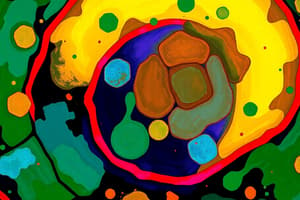Podcast
Questions and Answers
What is the primary function of the cell membrane?
What is the primary function of the cell membrane?
- To control what enters and leaves the cell (correct)
- To store genetic material
- To produce energy
- To provide structure to the cell
Animal cells possess a cell wall.
Animal cells possess a cell wall.
False (B)
What is the primary component of the plant cell wall?
What is the primary component of the plant cell wall?
cellulose
Cytoplasm is approximately _____% water in many cells.
Cytoplasm is approximately _____% water in many cells.
Match the following terms with their definitions:
Match the following terms with their definitions:
Which statement about the cell wall is TRUE?
Which statement about the cell wall is TRUE?
Vesicles are larger than vacuoles in animal cells.
Vesicles are larger than vacuoles in animal cells.
What do plant vacuoles contain?
What do plant vacuoles contain?
The primary function of the vacuole in plant cells is to help maintain the cell's _____ by pressing outwards.
The primary function of the vacuole in plant cells is to help maintain the cell's _____ by pressing outwards.
Which of the following is NOT a type of metabolic reaction?
Which of the following is NOT a type of metabolic reaction?
Flashcards
Cell Membrane
Cell Membrane
A thin layer surrounding the cytoplasm of every cell, controlling what enters and leaves.
Partially Permeable
Partially Permeable
Allows some molecules and ions to pass through, but not others.
What does the cell membrane do?
What does the cell membrane do?
It controls what goes in and out of the cell, acting like a gatekeeper.
Cell Wall
Cell Wall
Signup and view all the flashcards
Fully Permeable
Fully Permeable
Signup and view all the flashcards
Cytoplasm
Cytoplasm
Signup and view all the flashcards
What are metabolic reactions?
What are metabolic reactions?
Signup and view all the flashcards
Vacuole
Vacuole
Signup and view all the flashcards
What is cell sap?
What is cell sap?
Signup and view all the flashcards
Vesicle
Vesicle
Signup and view all the flashcards
Study Notes
Cell Structure
- Cells have a cell membrane, a thin layer of protein and fat, which controls what enters and leaves the cell. It is partially permeable, allowing some substances to pass through but not others.
- Plant cells have a cell wall made mainly of cellulose. This gives strength and support to the cell. The cellulose forms fibres that criss-cross over each other. The cellulose cell wall is fully permeable, allowing large molecules to pass through it.
- Cytoplasm fills most of the cell and is mostly water (around 70%). Metabolic reactions take place in the cytoplasm.
- Vacuoles are fluid-filled spaces inside cells, surrounded by a membrane. Plant cells have large, permanent vacuoles, filled with cell sap, which help maintain shape. Animal cells have smaller vacuoles called vesicles.
- Plant cells are surrounded by a cell wall, making it hard to view the cell membrane.
- Animal cells do not have a cell wall.
Cell Types
- Plant cells are surrounded by a cell wall, while animal cells are not.
- Plant cells have large permanent vacuoles whereas animal cells have smaller vacuoles (vesicles).
Studying That Suits You
Use AI to generate personalized quizzes and flashcards to suit your learning preferences.





